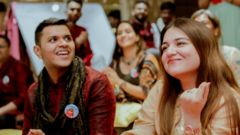Recently, a new party trend has taken the vibrant Indian social scene by storm: fake weddings. These extravagant celebrations encompass the traditional opulence associated with Indian weddings—glittering outfits, lively music, and sumptuous food—minus the central element of marriage itself. With young Indians looking for novel ways to celebrate, fake weddings have emerged as popular ticketed events hosted in cities like Delhi, Mumbai, and Bengaluru.
Attendees, primarily from the Gen Z demographic, flock to these curated parties to partake in the fun without the pressures often associated with real weddings. Participants experience a full-fledged wedding atmosphere, complete with dance, food, and the joyous spirit of celebration. Last week, a fake sangeet event in Delhi showcased this trend in full swing as attendees donned their finest traditional attire and danced to the beats of the dhol.
Shivangi Sareen, who attended such an event, expressed her delight, noting that the atmosphere was more relaxed compared to family weddings. "At family weddings, there's so much pressure,” she shared, appreciating the ability to enjoy with friends without judgment or guidelines. Ticket prices generally range from 1,500 to over 15,000 rupees based on the venue, highlighting that many are willing to invest in this unique communal experience.
The trend is also reshaping the hospitality landscape. Restaurateur Sharad Madan pointed out that novelty is pivotal in attracting patrons, while Kaushal Chanani of 8Club events emphasized the concept's roots in the experiences of young Indians abroad, who often gather for Bollywood dance and ethnic attire.
Not all fake wedding events follow the same script. For instance, a recent sober sangeet in Bengaluru, hosted by Third Place, omitted alcohol while incorporating traditional festivities such as games and grand welcomes. Anurag Pandey, CEO of Third Place, wanted to encapsulate the essence of Indian weddings, steering clear of excesses often found in nightlife.
The phenomenon reflects a broader cultural craving among young Indians for celebratory occasions. Writer Santosh Desai captured the sentiment perfectly, noting how the wedding setting presents an ideal backdrop for fun, stripped of emotional pressures.
Event planner Vijay Arora suggests that while fake weddings might initially seem like a fleeting fad, they hold the potential to establish a new market category, contributing significantly to the multi-billion-dollar wedding industry in India. Such events could become a staple, especially during off-seasons when traditional weddings are less frequent.
However, as with any trend, reactions are mixed. Srishti Sharma, a young professional, reported her disappointment after attending a lackluster event that failed to live up to expectations. Critics have also raised concerns over whether these celebrations trivialize the cultural significance of traditional weddings.
Despite varying opinions, attendees like Vidhi Kapoor maintain that such events foster a different, joyful celebration that should be appreciated for what they represent—a fun gathering among friends reminiscent of Indian wedding festivities, without entangling commitments.
As fake weddings continue to grow in popularity, one key question remains: are they here to stay, or will they fade into the history of experimental celebrations?



















